Bowfishing offers followers a one-of-a-kind and thrilling experience by fusing the excitement of fishing with the accuracy of archery. With the help of our in-depth tutorial, you will get the information and abilities necessary to become a proficient bowfisher, regardless of your level of experience.
Understanding Bowfishing Basics
1. The Right Equipment:
- Bow Selection: Choosing the right bow is crucial. Specialized bowfishing bows are designed to withstand the harsh aquatic environment and allow for attachments like reels and lights.
- Bowfishing Reels: Explore the variety of bowfishing reels, including drum reels, spin-cast reels, and retriever reels, each offering unique advantages for different scenarios.
- Bowfishing Arrows: Opt for arrows with specialized tips designed for penetrating water and securing your catch. Ensure they match the draw weight of your bow.
2. Setting Up Your Bow:
- Adjust Draw Weight: Modify your bow’s draw weight to match the requirements of bowfishing. A heavier draw weight helps generate the force needed for arrow penetration through water.
- Adding Accessories: Enhance your setup with accessories like stabilizers, lights, and sights, improving accuracy and visibility during nighttime bowfishing.
3. Navigating Bowfishing Waters:
- Shallow Waters: Target shallow areas where fish gather, such as flats, shorelines, and marshes. These areas increase your chances of spotting and successfully shooting fish.
Targeting and Shooting Techniques
1. Identifying Target Species:
- Common Bowfishing Targets: Learn about popular bowfishing species like carp, gar, and buffalo fish. Understand their behavior and habitats for a successful bowfishing expedition.
2. Aiming and Shooting:
- Refraction Considerations: Account for refraction when aiming at fish underwater. Aim lower than the actual position of the fish to compensate for the bending of light in water.
- Shot Placement: Focus on targeting the vital areas of the fish, aiming for the head or behind the gill plates for an ethical and effective shot.
Best Practices for Bowfishing Success
1. Environmental Stewardship:
- Ethical Practices: Practice catch and release when targeting non-invasive species. Promote responsible bowfishing to preserve aquatic ecosystems.
2. Legal and Safety Considerations:
- Check Local Regulations: Be aware of bowfishing regulations in your area. Obtain the necessary permits and follow catch limits to contribute to sustainable bowfishing practices.
- Safety Precautions: Prioritize safety by wearing polarized sunglasses, using bowfishing gloves, and ensuring proper boat and equipment maintenance.
Embracing the Bowfishing Lifestyle
1. Community and Competitions:
- Connect with Fellow Bowfishers: Join local bowfishing clubs or online communities to share experiences, tips, and advice. Engage in friendly competitions to refine your skills.
2. Choosing the Right Bowfishing Bow:
- Explore Options: Visit cheerfulfisherman.com to explore a diverse range of bow fishing bows. From entry-level options to advanced bows, find the perfect companion for your bowfishing journey.
More than just a sport, bow fishing is a dynamic combination of fishing and archery that creates new opportunities on the water. To get the most out of your bowfishing experiences, arm yourself with the appropriate information, fishing equipment, and moral values. For a carefully chosen assortment of bowfishing gear, including accessories, visit cheerfulfisherman.com to make sure you’re ready for the best bowfishing experience possible. Take a deep breath and enjoy the excitement of bow fishing now!







2 Comments
Comments are closed.